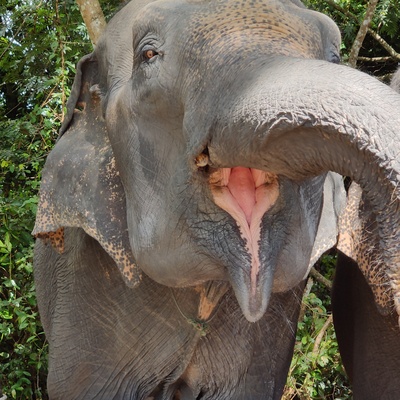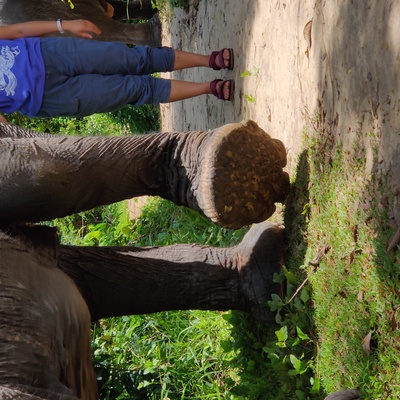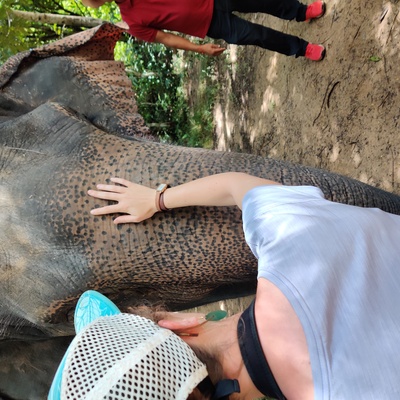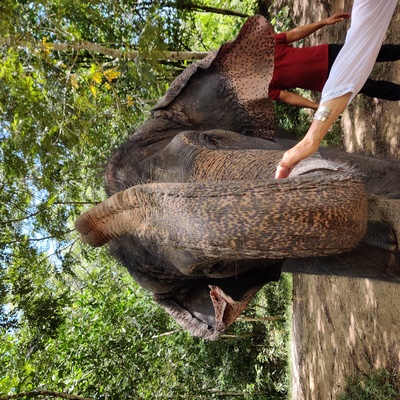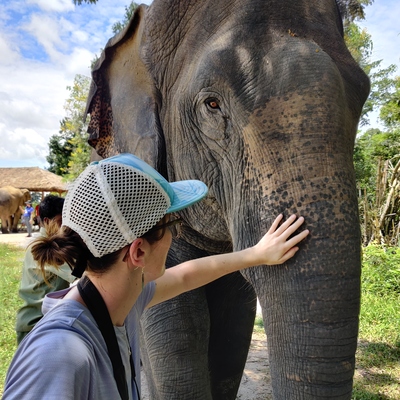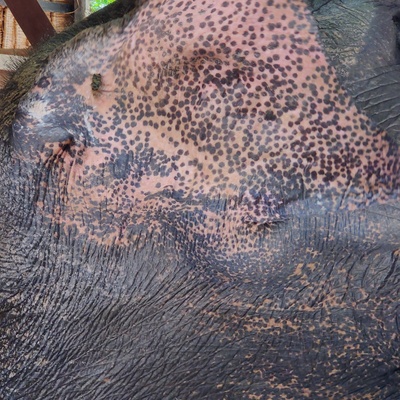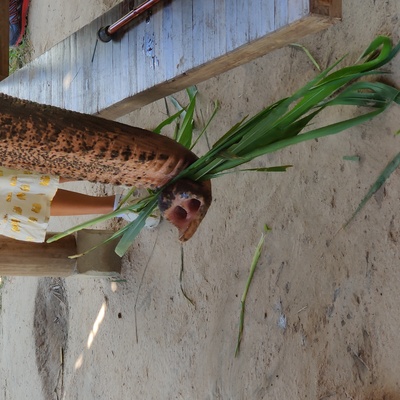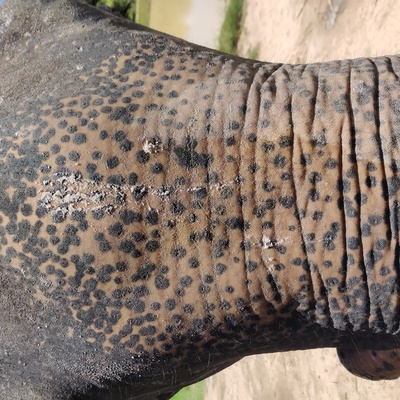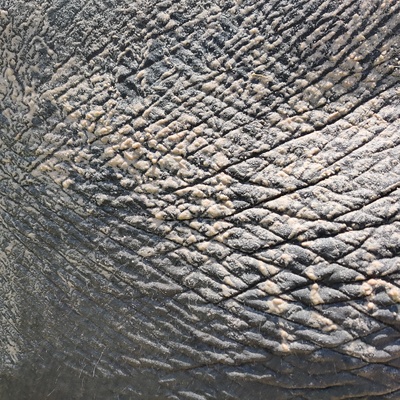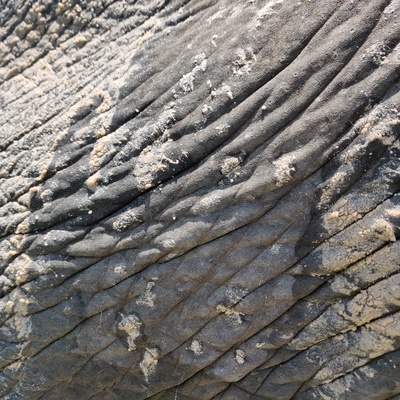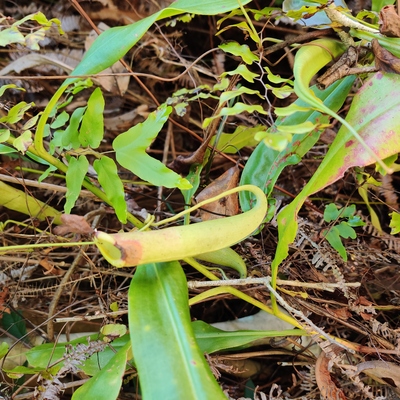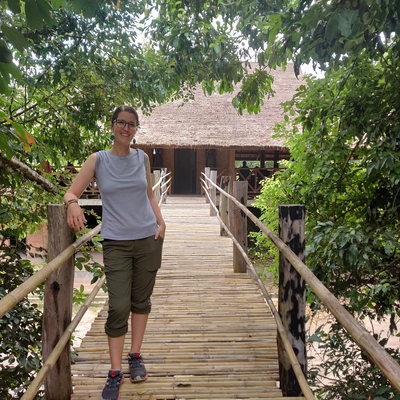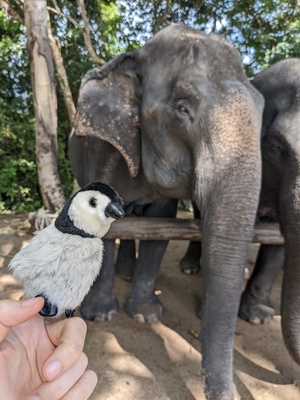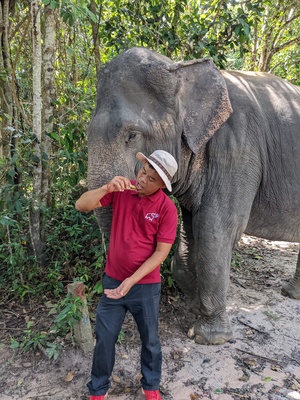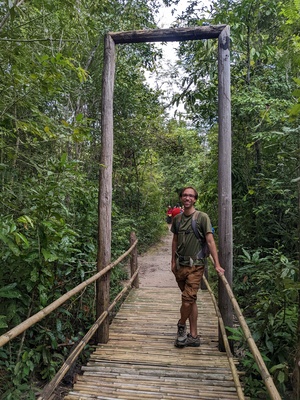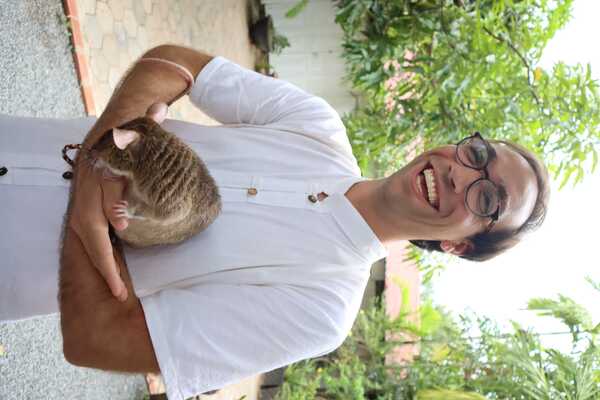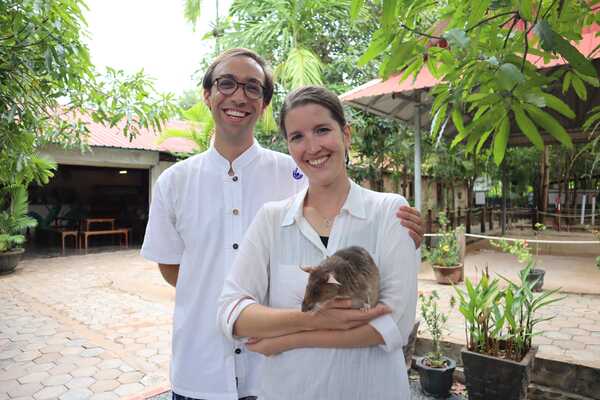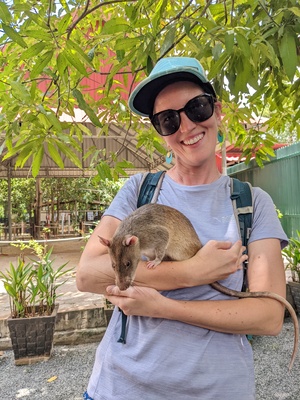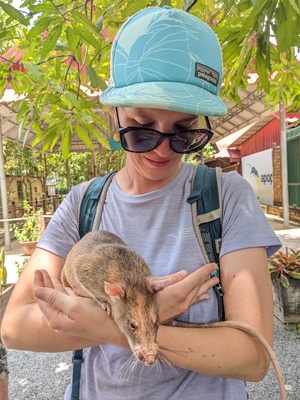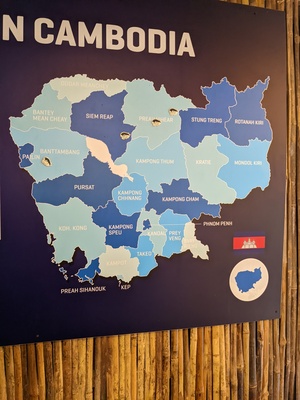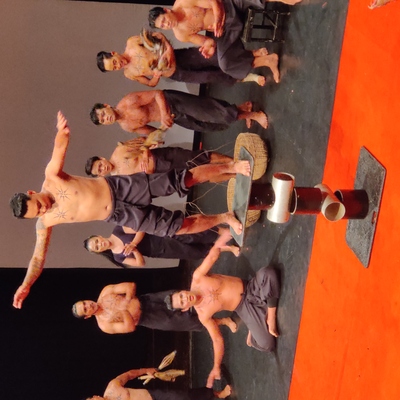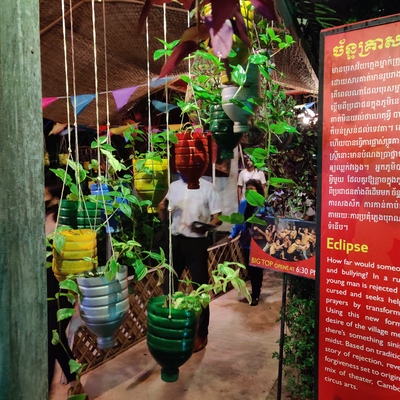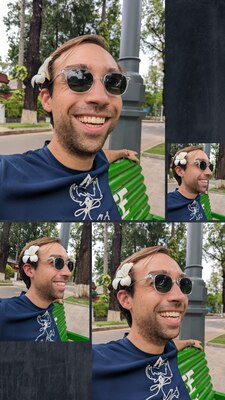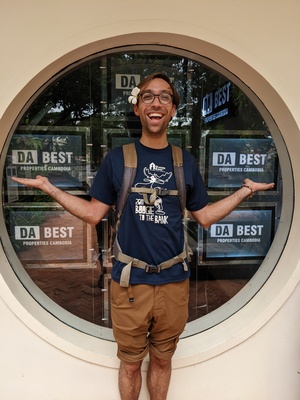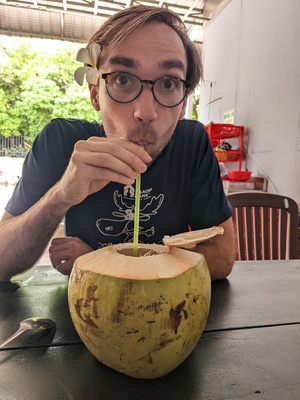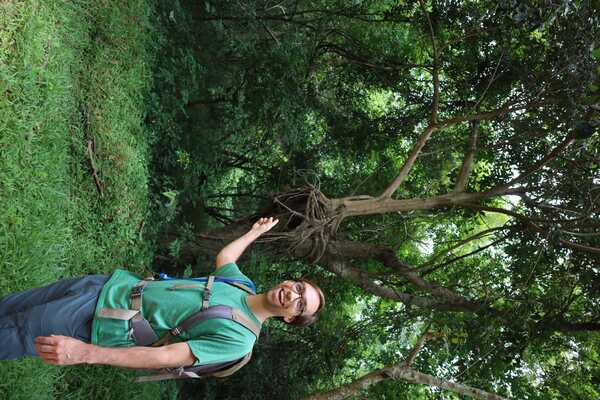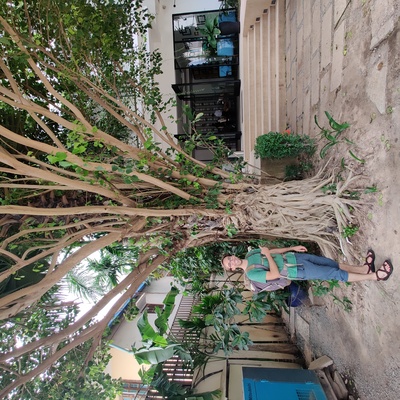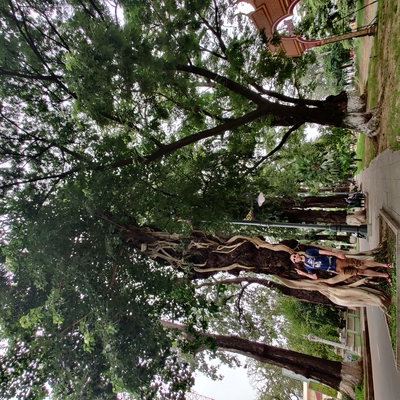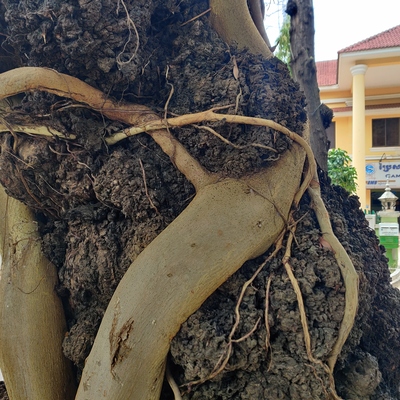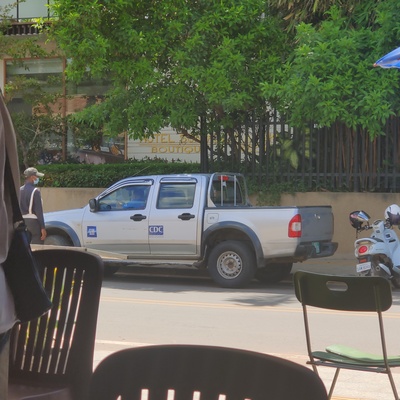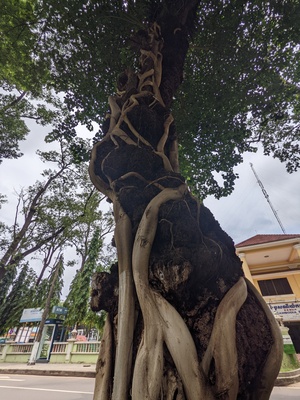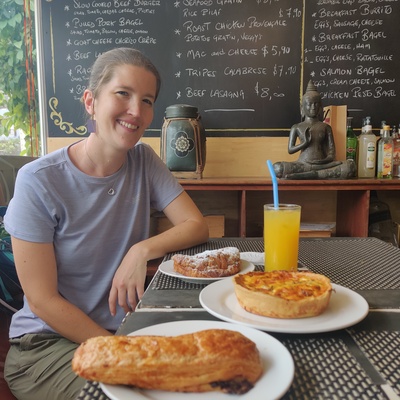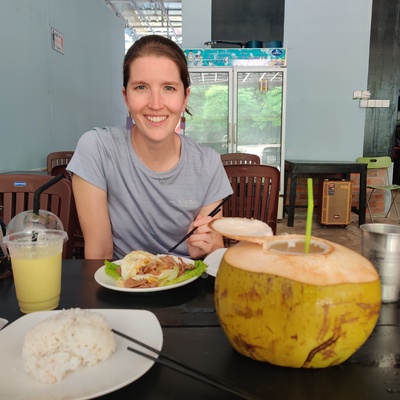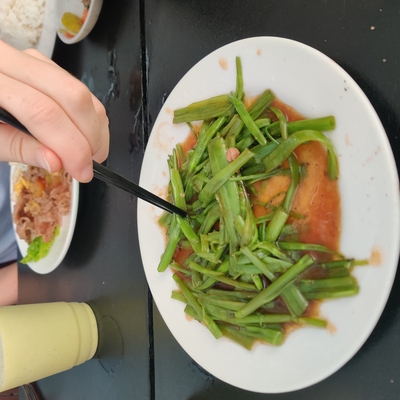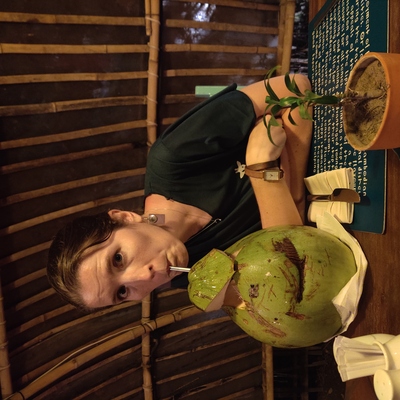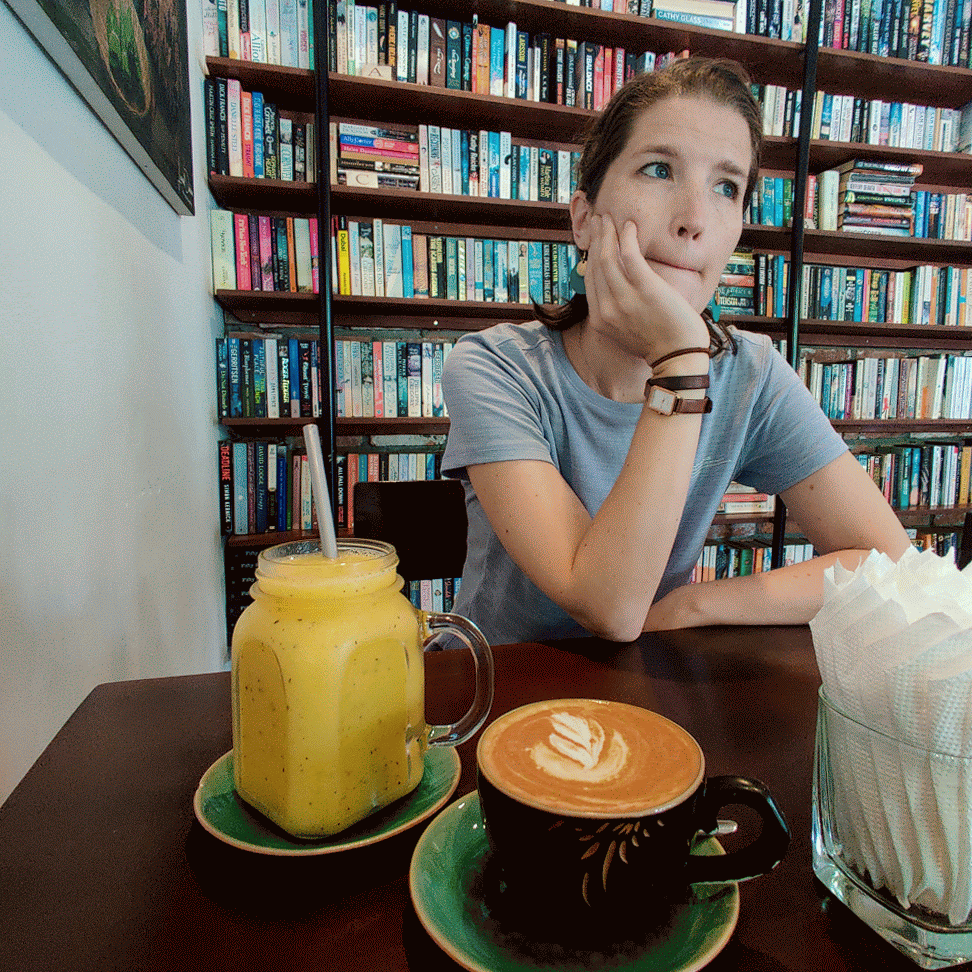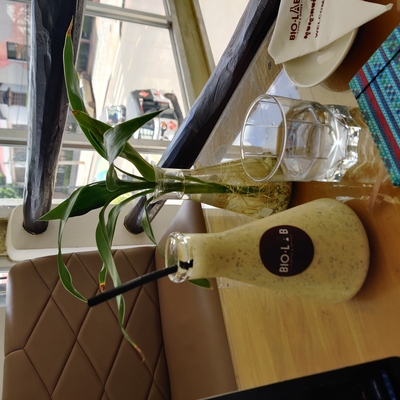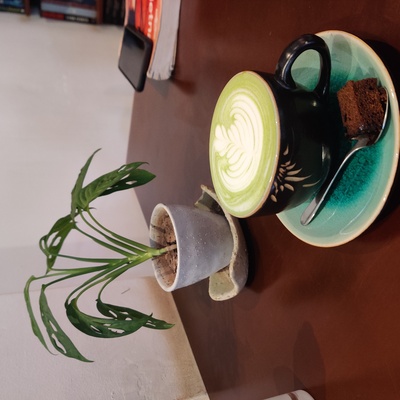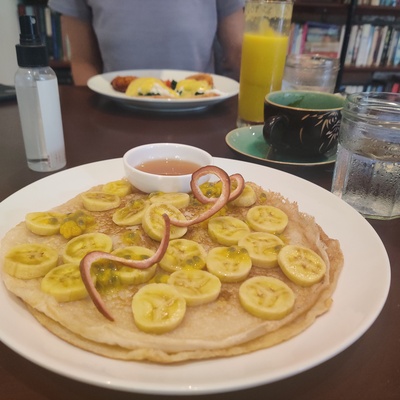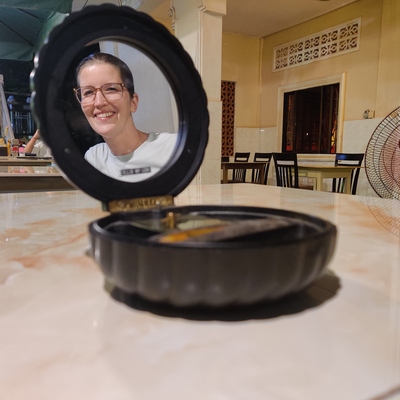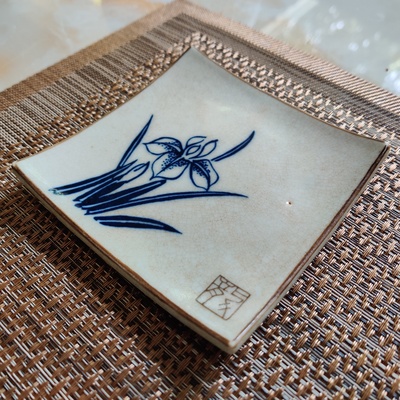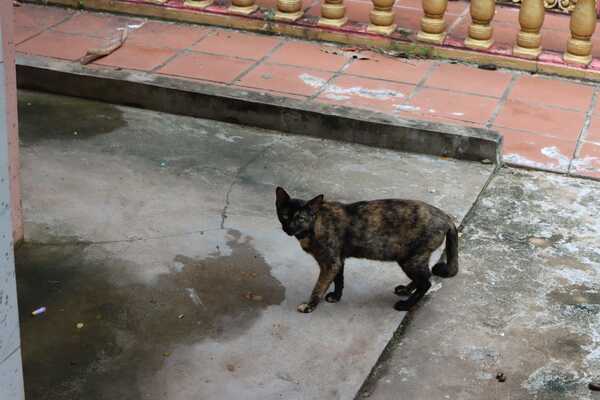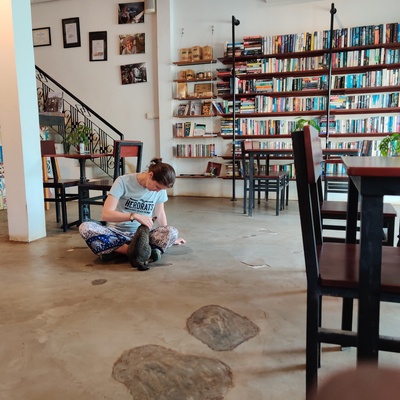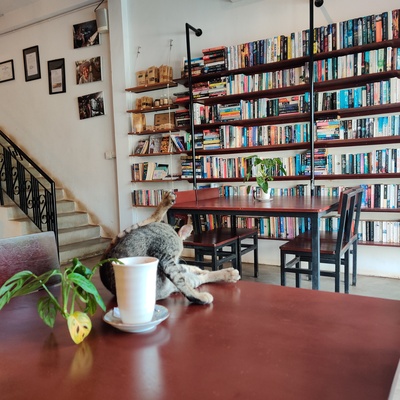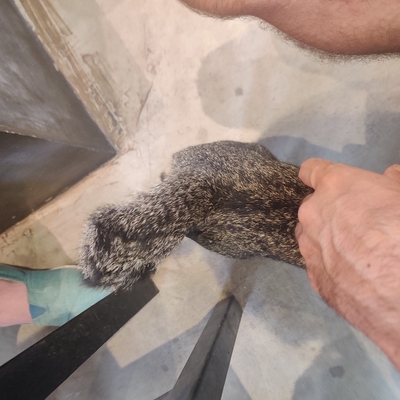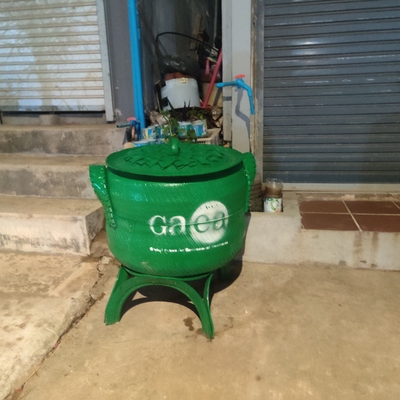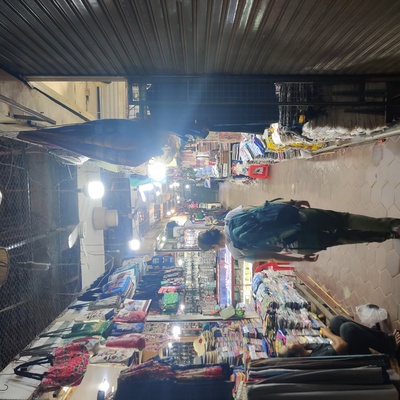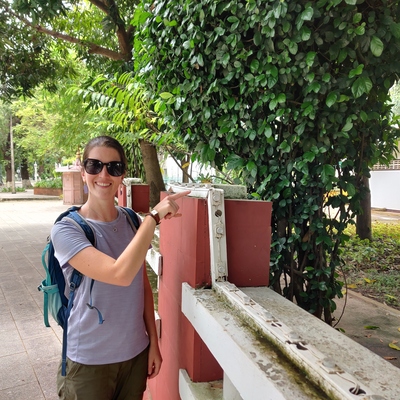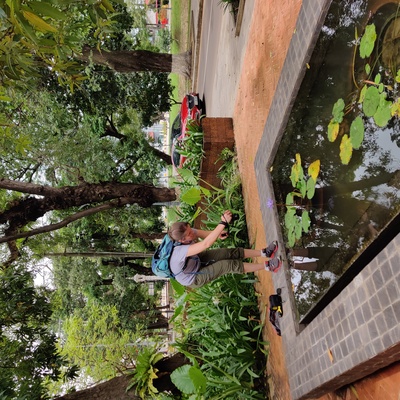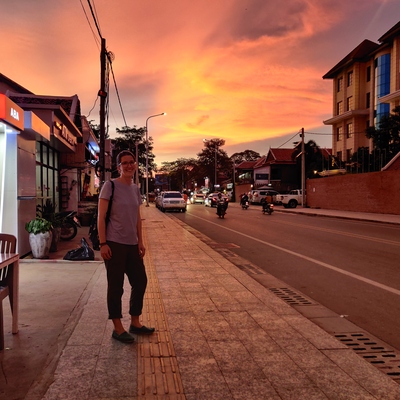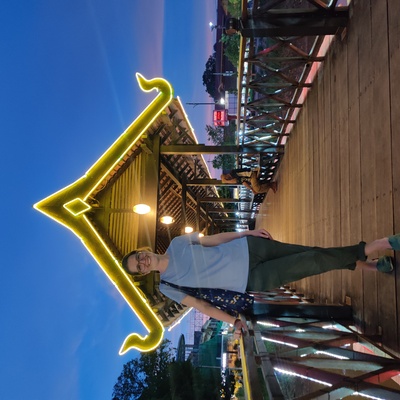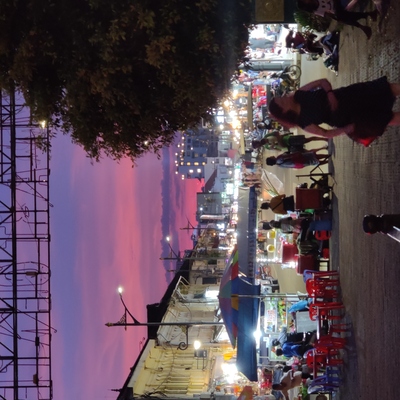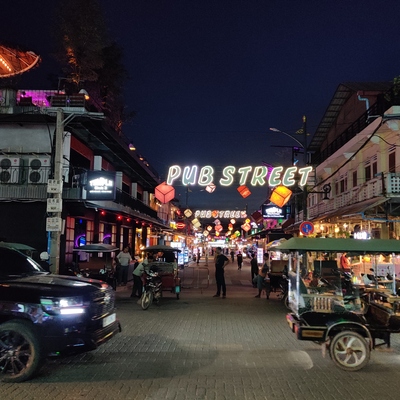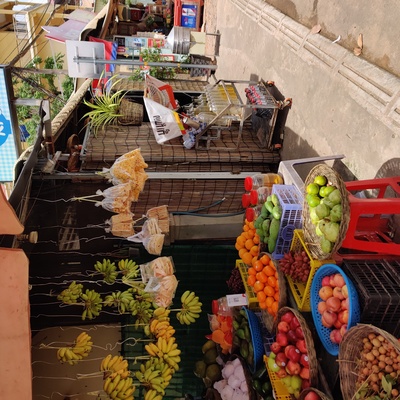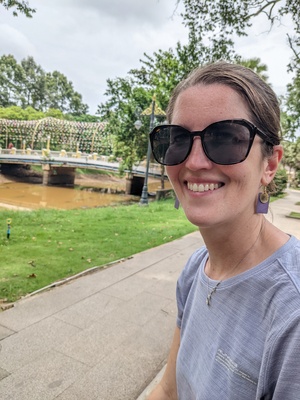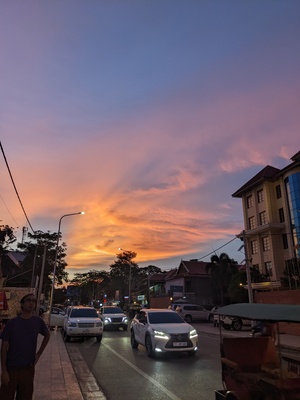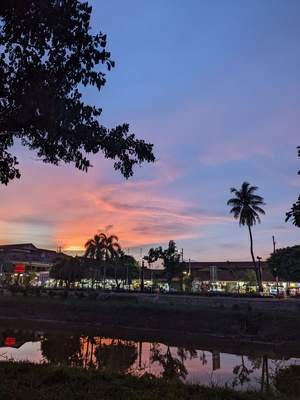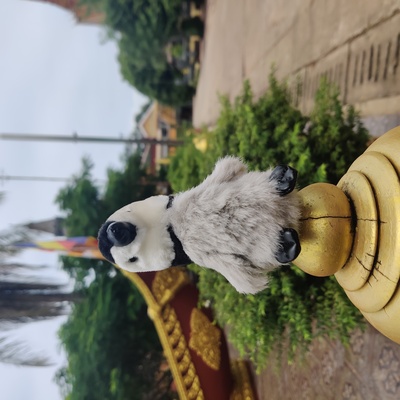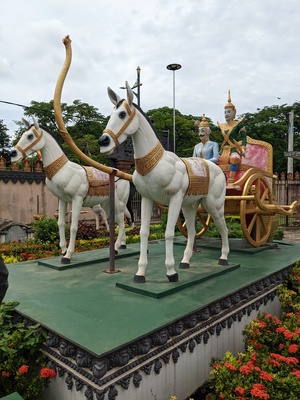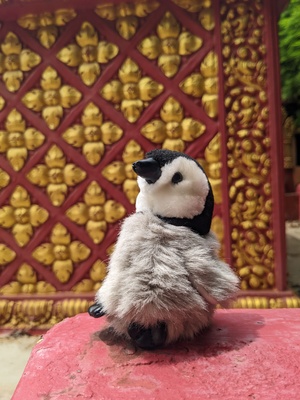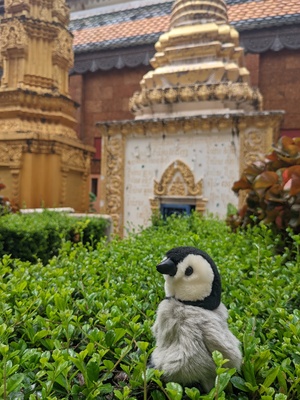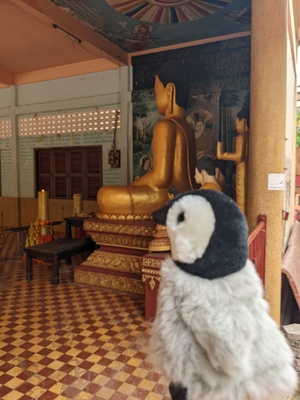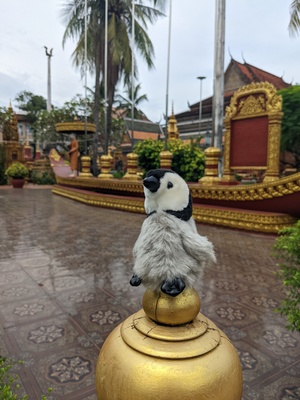Siem Reap
Kulan Elephant forest
I tend to be skeptical of the ethics of any animals in captivity and especially ones involving large mammals. I also love interacting with them. It brings me tremendous joy and fills me with wonder about the world.
When researching Siem Reap I had come across The Kulan Elephant Forest. It was a tourist attraction that advertised saving elephants from tourism. Which seemed like a contradiction. Skeptically I added it to the list of “maybe” activities.
On our first day at Angkor Wat, we ended up chatting with a lovely woman who was working at an NGO in the area. We had a wonderful conversation learning that she came here on holiday and ended up living here for several years. While in Cambodia on the holiday, she learned about a grant for folks to help out with a special needs school and took the job. She told us much of what it was like before and after COVID.
In pre-COVID times there used to be elephants at the Angkor Wat temple. They would offer rides to tourists no matter the time of day or weather conditions. Sadly, this lead to the death of one of the elephants in 2019. This in combination with the pandemic provided the right opportunity for a wealthy donor to purchase the animals and “retire” them to a sanctuary. After getting the back story and having someone who has lived in the area for a while vouch that the organization seemed ethical. We moved it to our “must-do” list. And I am glad we did.
The experience was wonderful and it seemed like they were doing their best to care for the animals. We started the day by taking a bus 40km north to the forest where we got to feed the elephants some treats (bananas and sugar cane), went on a short 3km hike and then came back to watch them take a bath and feed them some king grass (A hard to cultivate grass that is one of their favorites).
I was humbled and intimidated by their presence. They are huge animals! The guides explained to us the dos and don’ts which all seemed like basic respectful behavior. Such as: don’t pull on their tails. Or let the elephant approach you not the other way around. Or If they back away from you let them. And Don’t take away food after offering it to them.
At one point another visitor approached me and said I had ‘elephant face’. Referring to my ear-to-ear smile. Additionally, the tour guide was super knowledgeable and we learned a lot about Asian elephants. including:
- They are smaller and browner than their African counterparts
- While capable of longer lives they often die around 45 years old due to starvation. Their molars wear out and then they can’t get enough soft food in the dry season. To combat this the sanctuary makes massive dishes of bananas and rice for their older elephants to help them through the dry season
- Elephants are capable of recognizing them selfs in the mirror
- They can swim up to 1km
- They can hold their breath for over two minutes
- Are capable of running 40km in a single hour
- An elephant’s gestation period is 21-23 months
- At the sanctuary, they are trying to breed the elephants and have found that if the females are not attracted to the males they will go hide in the woods and the animals won’t breed
Apopo Visitor Center
Apopo was on my must-do in Siem reap list. They are an organization that uses blind rats to sniff out and find landmines! The tour was very educational and also heartbreaking. I struggle to come to terms with how evil landmines are. They are horrific weapons. A few facts that drive how diabolical they are:
- Many are specifically designed to maim and not kill
- They cost about 10 to 30 times more to remove than they do to create. A negative externality created by the wealthiest countries and paid for by some of the poorest. Creating physical suffering, delaying development, and dividing communities.
- The majority of people they kill/injure are not those involved in the conflict
The visitor center did a great job of breaking down some of the lasting effects on the communities. On the tour, we learned about how they are working to remove landmines in Cambodia and worldwide. They are using three main tools metal detectors, dogs and the African pouch rats for finding the mines. Each has its strengths but the rats stand out as the fastest, safest and most accurate.
We learned that the rats are bred and trained in Tanzania. An unexpected connection to our previous travels! The rats are incredibly smart and clever. While they can not be domesticated they are trained to sniff out TNT and scratch the ground in the location of the smell. This makes them advantageous to metal detectors as they can ignore scrap metal and find plastic landmines. When compared to the dog they are advantageous as they have yet to have a false positive in the field and are light enough to not set off the mines.
Currently, the ~60 rats have a perfect tract record of finding all mines in the swept area. A fact that is verified by a second rat, a metal detector and then a separate independent check by the Cambodian government. Apopo is doing amazing work and you should follow them on their social (they have tons of cute videos of rats):
Phare Circus
The Phare Circus was a lovely night out. We paired it the same day as the Kulan Elephant Forest and ended up meeting two of the couples who were on the Elephant tour with us. There was a nice shop and a cafeteria with a number of cooks making different dishes. It had been a while since either of us have seen live performance art and the group here was amazing. They combined acrobatics with physical storytelling. The storytelling was so good that it made the screens running the translation unnecessary. After the show, we picked up some gifts at the shop and then experienced our first downpour. Being here during the rainy season we were expecting heavy rains every day but it has been surprisingly sunny and fair
Flower in your hair
I rarely receive compliments about my appearance. I think this is largely due to my gender. Today (8/21) I picked up a flower at Wat Preah Prom Rath. I was pleasantly surprised by the attention it brought to me. It seemed to bring a little surprise and a lot of joy. The flower lasted about 2 hours before wilting but in that time I received many compliments. Here are some of my favorites:
- In Old Market, I was facing a shopkeeper with my side opposite the flower. She was giving me the normal sales pitch trying to get me to buy a t-shirt, coaster, silk scarf, etc. As soon as I turned my head to say no thank you she started giggling and in excitement told another shopkeeper in Khmer about me. They were both happy and excited.
- On our way from Old Market to the Made in Cambodia Market, a tuk-tuk driver called out to us. In our time tuk-tuk drivers will all stop and ask us if we want a ride. This one just smiled genuinely and he said “I like your flower”
- In the Made in Cambodia Market, a woman saw my flower and exclaimed “Oh! Flower in your hair! I like!” while wiggling in excitement
- Another vendor hesitant at first eventually worked up the courage to say “Nice flower!” to me.
The entire interaction had me reflecting on what we associate with gender and having just been in Texas. I thought about how differently the interactions would have played out there. I think there are only a handful of places in the US where I would be comfortable walking around with a flower (all of which are metropolitan).
Escaping work
One of the many reasons for this trip was to escape from work for a while. We had a particularly stressful work experience during the pandemic and are both feeling quite burnt out. We wanted to spend some time reconnecting with the world, our values, ourselves and each other before reentering the workforce. However, it turns out that even on the other side of the world there are reminders.
For context, I had spent my last 6 months with the CDC advocating for the modernizing of a legacy system using Strangler Figs as a metaphor. And lo a behold, halfway across the world, what do I run into but many strangler figs and the CDC.
The Food
The food in Siem Reap was amazing! Passion fruit smoothies quickly became an everyday staple. The fruit was incredibly fresh and for only $2 USD they were too good not to add to every meal. They were the perfect refreshing drink to beat the heat. Cold and sweet with a blast of tartness from the seeds. The only problem is our waistlines. Ordering a smoothie with every meal (and in between meals) quickly adds up. We are eating far more than we are used too.
Normally, our meals while traveling look like this:
- A light breakfast like a small bowl of cereal and possible some fresh fruit or juice and a black coffee for Tim
- For lunch a PB&J and assorted snacks
- Go out to eat for dinner or make a meal where we are staying
However, in Siem Reap food was so good, cheap, and fast our meals became:
- For breakfast was some combination of pastries and quiche from the Paris Bakery or splitting an order of eggs florentine and french toast from footprints cafe. And always with fresh fruit, a smoothie and a latte for Tim
- Lunch was consistently street food usually Lok Lak, Amok, or fried morning glories with a fresh coconut
- Dinner was a full meal with appetizers, entrees and desserts. And always with more smoothies. We found both great french and Cambodian food. Our favorite spots are JOMNO, HAVEN, and La Kh’Mère Poulart
Cat
We have talked a lot about how Paka looks different from the cats we are used to in the USA. Describing her proportions or minute facial differences. In Cambodia, cats are referred to as tailless. As their tails are short and end in a nub. A much more obvious difference than the long thin tails of cats in the states. I joked about bringing on back to breed with Paka to start a new breed of house cat. But Alas, we choose not to adopt a cat here. Given that the street cats are well feed and cared for by the monks and residents.
City
Exploring the city was fascinating. It felt new and exciting. With many immaculate gardens, beautiful templates, and lovely people. A few things stuck out to me as particularly interesting.
- The city had come up with an ingenious way of reusing old tires. Turning them into rubbish bins that are aesthetically pleasing and functional. They seemed to have a trash can on every block.
- There seemed to be a much higher adoption rate of LED lighting than in the US. Strips of LEDs lined bridges, walkways and fences. It seems that the high relative cost of electricity has really driven their adoption.
- There weren’t many formal gas stations with underground storage and pumps as we are used to. However, it seemed that every street vendor was selling gas in old plastic water bottles and glass liquor bottles.
- Every bathroom and reusable cloth towels!
Many of the markets that we found recommended online were full of dozens of vendors selling the same cheaply made items from China. We had to look around a bit more to find more locally-made goods. Thankfully we found Made in Cambodia Market, the Phare Circus shop and SATU. Which stocked plenty of goods from local artist. We are nervous about carrying around too much weight with a month in Vietnam next but we can always mail things home. And when you see something you love halfway around the world you have to buy it. #noRegrets
Temple
And here are some photos of Dr. Speckles exploring Wat Preah Prom Rath

